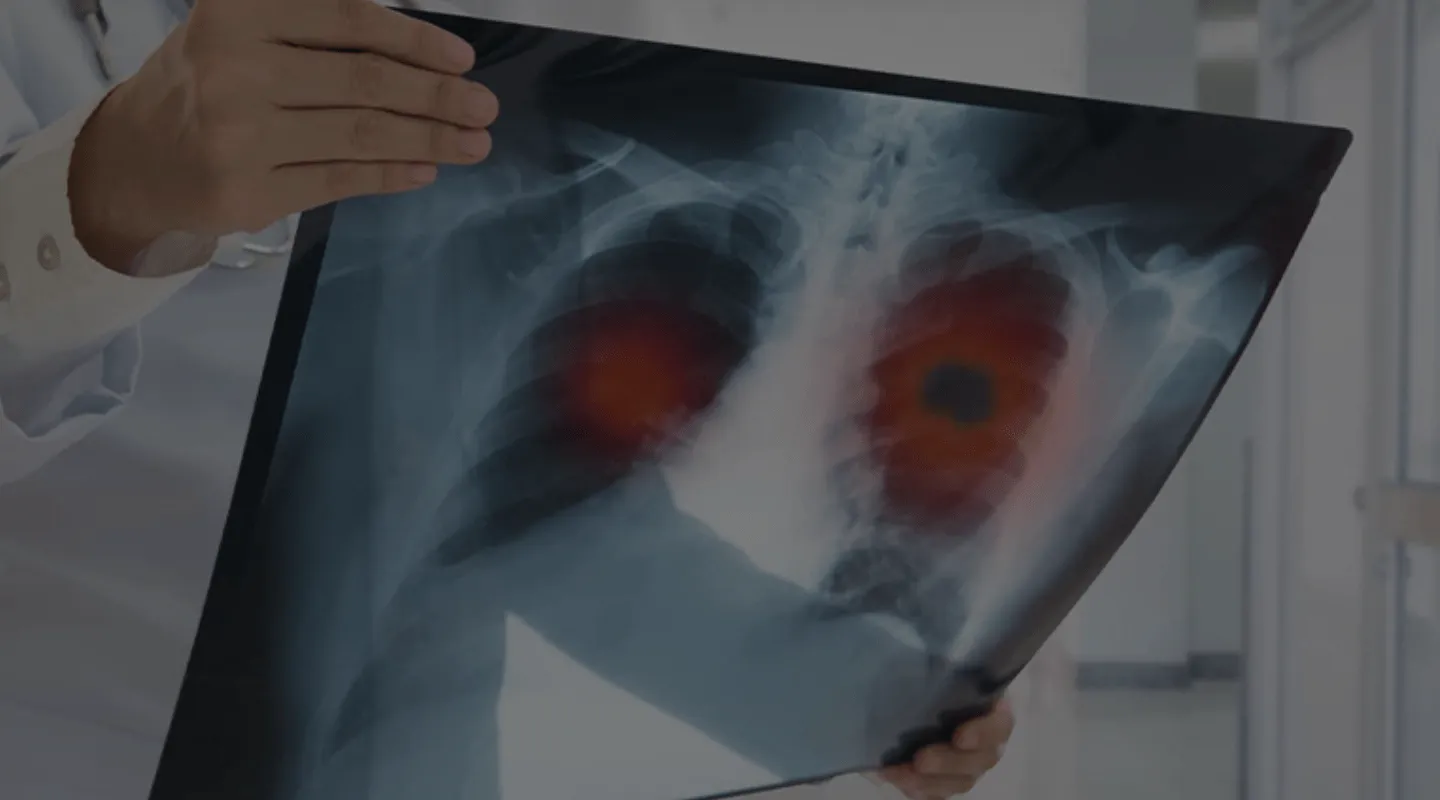
Lung Lobectomy
Your Lung Lobectomy in Tunisia at an Affordable Price
A medical stay organized from A to Z, including consultation, surgery, hospitalization and post-operative follow-up.
How does it work?
What is a Lobectomy?
A lobectomy is a surgical procedure that involves removing a lung lobe, one of the sections that make up a lung. Each lung is divided into sections called lobes; the right lung has 3, and the left lung has 2. Therefore, when a problem affects only one part or one lobe, the affected area can be removed, preserving the healthy part of the organ.
Why is a Lung Lobectomy Performed?
A lobectomy is performed to treat various lung diseases or problems such as:
- Lung cancer;
- Congenital lung defects;
- Lung abscess;
- Cysts;
- Emphysema;
- Fungal infections;
- Tuberculosis;
- Benign tumors;
Lobectomy Price in Tunisia
By choosing to have your lung lobectomy in Tunisia, you benefit from an affordable procedure in state-of-the-art medical facilities. Our packages include the clinic fees and all costs necessary for your lobectomy. Contact us for more details.
Your health, our priority.
Request your free quote.
What does a lung lobectomy consist of?
Preparation for Lung Lobectomy
For good preparation for lung lobectomy, the patient must be informed of everything that the surgical procedure in question involves. It is essential to carry out a complete preoperative assessment to ensure that the patient is ready to undergo the procedure. The patient must follow the following guidelines:
- Stop smoking;
- Fast for eight hours before the operation;
- Stop taking medication if indicated by the specialist.
- A possible pregnancy of the patient;
- Patient allergies:
- Blood diseases or disorders;
- Management of anticoagulants by the patient.
How is a lung lobectomy performed?
Lung lobectomy is the surgical removal of a lobe of the lung, performed by isolating and dissecting the corresponding arteries, veins, and bronchi. The operation, which requires general anesthesia, can be performed using two different approaches: one is minimally invasive and the other involves a thoracotomy, i.e., with an incision of about 20 cm or more on the thorax which involves separating the ribs. The minimally invasive approach, developed in recent years, is called video-thoracoscopy and can be performed with one or more incisions in the chest wall. The latest development in the field of minimally invasive lung surgery is uniportal thoracoscopy. It is based on an incision of only 3 or 4 cm through which a special camera and all the instruments that allow the elimination of the disease are inserted with oncological results absolutely superimposable to those of traditional “open” surgery. This technique offers enormous advantages for the patient, both in terms of aesthetics and speed of postoperative recovery. At the end of the operation, one or two drains are placed depending on the type of approach.
What are the postoperative consequences of a lobectomy?
After the lobectomy, rehabilitation is followed to train the lungs to expand and contract again. Most people stay in the hospital for two to seven days after the operation, although the length of stay depends on the type of operation and other factors. It is recommended, during the hospitalization period, to avoid lifting weights for six to twelve weeks, or until the doctor deems it appropriate.
After your lobectomy, you should follow an appropriate diet and exercise to speed up your recovery. Be sure to avoid the following activities and situations during your convalescence after a lobectomy:
- smoking;
- exposure to chemical fumes in the air;
- exposure to pollution;
- exposure to people with upper respiratory infections, such as the flu or cold.
What are the risks associated with the operation?
- infection;
- hemorrhage;
- a bronchopulmonary fistula;
- a pneumothorax, which can cause the lung to collapse.
What are the benefits of a lobectomy?
- to slow or prevent cancer from affecting other organs;
- to prevent the spread of infections and diseases;
- to remove a part of an organ that hinders the functioning of other organs.
When to call the care team?
- Fever. Your care team will tell you at what temperature to report it;
- Chills or any other sign of infection;
- Pain, redness, swelling, drainage, or bleeding at the incision site;
- Shortness of breath, cough with or without green, yellow, or bloody mucus, difficulty breathing, or pain when breathing;
- Chest pain;
- Nausea and/or vomiting;
- You are coughing up blood or have large amounts of brown/bloody sputum;
- You feel dizzy or faint;
- You have irregular heartbeats;
- The surgical dressing is soaked with blood;
- Chest pain;
- Swelling, redness, warmth, tenderness, and/or pain in your leg or calf;
Our advantages


Some advice after a lobectomy
After your lobectomy, you may need the help of a family member or friend to perform your daily tasks until you feel better. Be sure to take your prescribed medications as directed to prevent pain, infection, and/or constipation. Call your team if you have new symptoms or worsening symptoms. There are ways to manage constipation after your operation. You can change your diet, drink more fluids, and take over-the-counter medications. Talk to your care team before taking any constipation medication. Taking deep breaths and resting can help manage pain, keep your lungs healthy after anesthesia, and promote good lymphatic fluid drainage. Try to do deep breathing and relaxation exercises several times a day for the first week, or when you notice that you are very tense.
Contact and request a quote for an angioplasty
If you are tempted to have your lung lobectomy abroad and you wish to organize your stay in Tunisia with a serious and experienced agency, trust the professionals of Tunisia Destination Santé. We will accompany you step by step in the preparation of your file and the organization of your stay. Our team is always at your disposal to assist and guide you through all procedures. Do not hesitate to contact us for more information and to request a free, non-binding quote for your lung lobectomy.
—
Frequently Asked Questions
Eligibility criteria generally include the presence of a localized tumor or specific lung diseases, sufficient lung function to withstand the loss of a lobe, and good general health to minimize surgical risks. Pulmonary function tests and chest scans are often used to assess these criteria.
In the long term, many patients report an improvement in quality of life, especially if the lobectomy was performed to remove a cancerous tumor. However, some may experience persistent limitations in lung capacity, requiring adjustments in physical activities.
Yes, minimally invasive techniques such as video-assisted thoracoscopic surgery (VATS) or robotic surgery are available. These techniques generally reduce postoperative pain, decrease the risk of complications, and speed up recovery compared to traditional open surgery.
The recurrence rate varies depending on the stage of cancer at the time of surgery and other individual factors. In general, recurrence rates for cancers detected at an early stage are lower than those for advanced cancers. Regular follow-up is essential to monitor for any recurrence.
Pulmonary rehabilitation includes breathing exercises, graded physical activity, and nutritional advice. It aims to improve respiratory capacity, strengthen muscles, and help the patient regain their previous activity level.
Long-term complications may include recurrent infections, healing disorders, decreased lung capacity, and cardiovascular problems. Regular medical follow-up is necessary to manage these risks.
Lobectomy is often considered the gold standard treatment for localized lung cancers because it allows removal of an entire segment of lung with sufficient safety margins. However, for some patients, alternatives such as segmentectomy or pneumonectomy may be more appropriate depending on the location and size of the tumor.
Before surgery, lung function tests, such as spirometry and the measurement of carbon monoxide diffusion (DLCO), are used to assess respiratory capacity. After surgery, these tests are repeated to monitor changes and guide rehabilitation.
Success criteria include the complete removal of the tumor or diseased area, a recovery without major complications, and sufficient lung function to allow for good postoperative quality of life. The absence of long-term recurrence is also a key indicator of success.
In elderly patients, lobectomy may be associated with a higher risk of complications due to the frequent presence of comorbidities and reduced lung reserve. However, with rigorous patient selection and careful pre- and postoperative management, the results can be comparable to those of younger patients.
